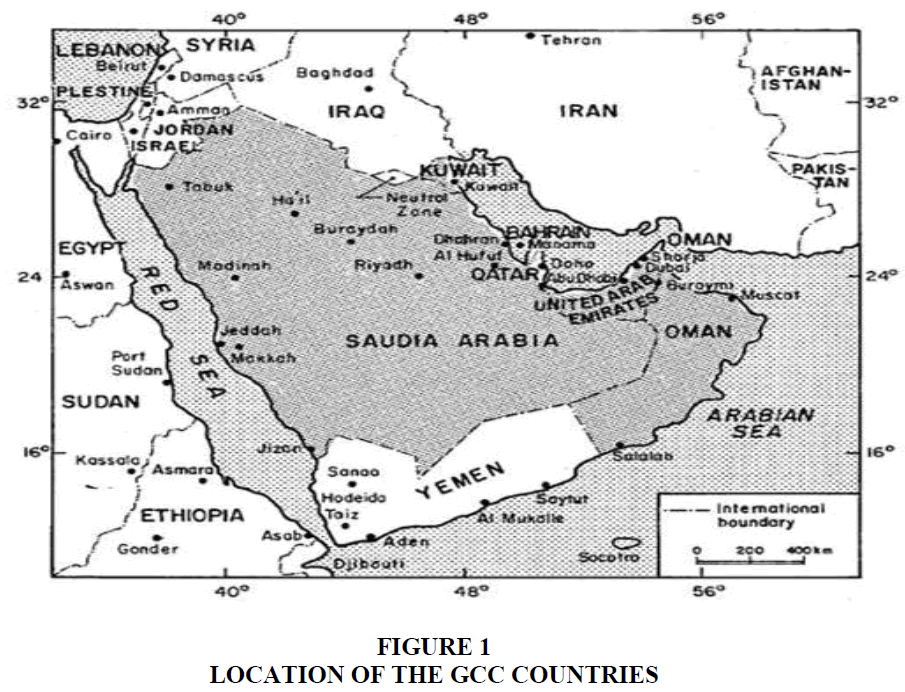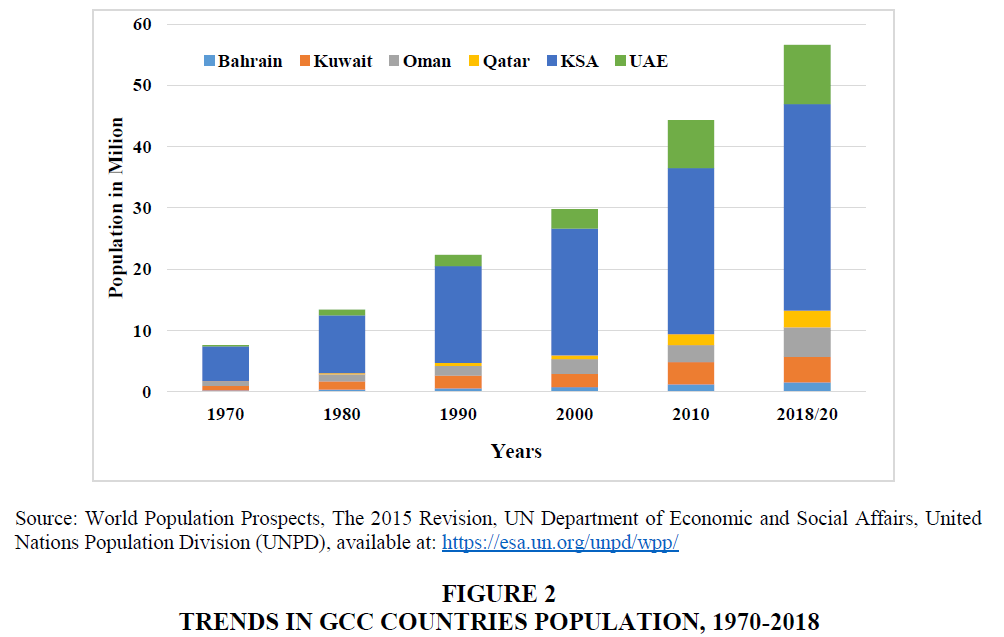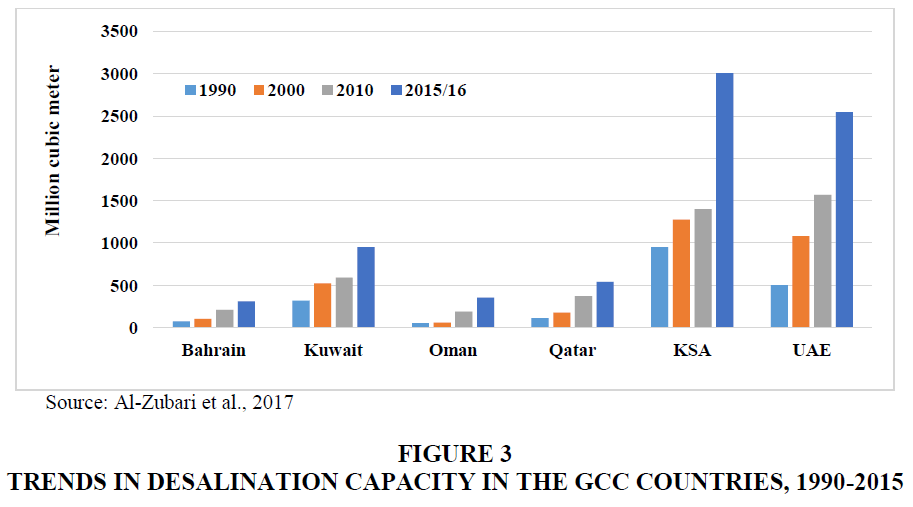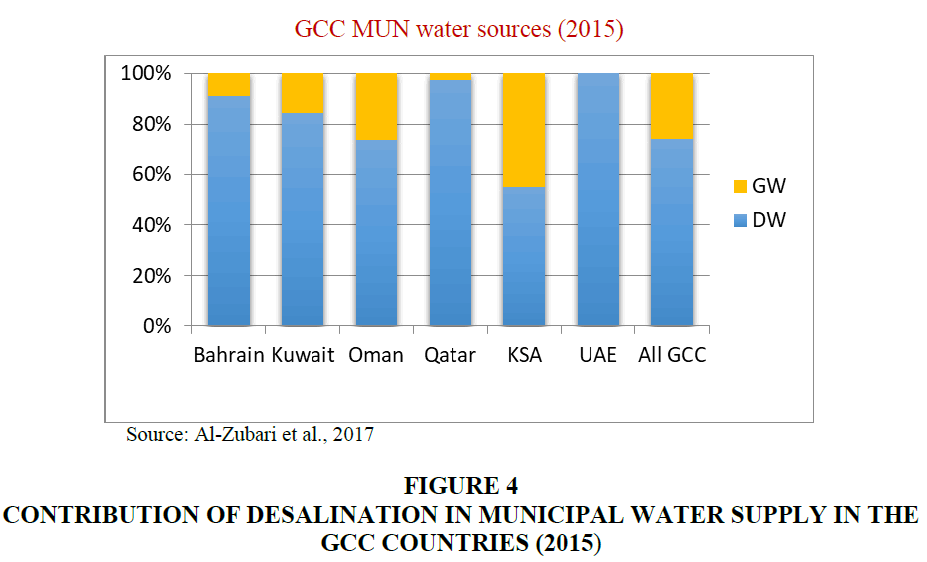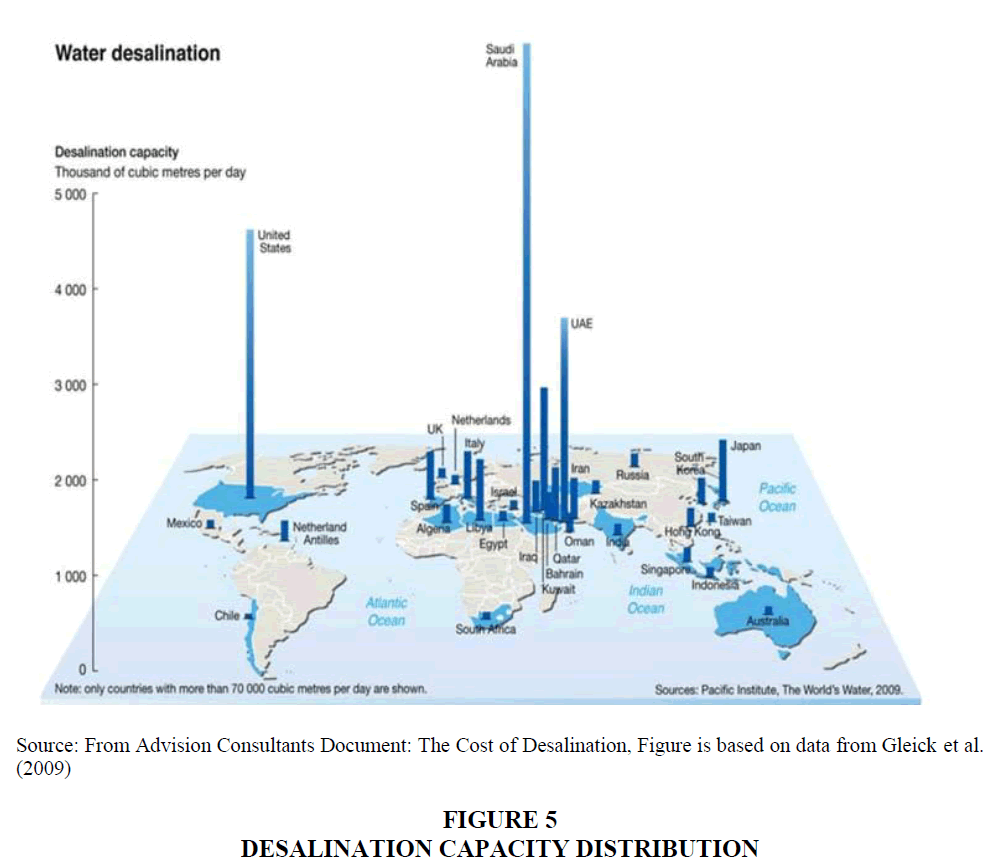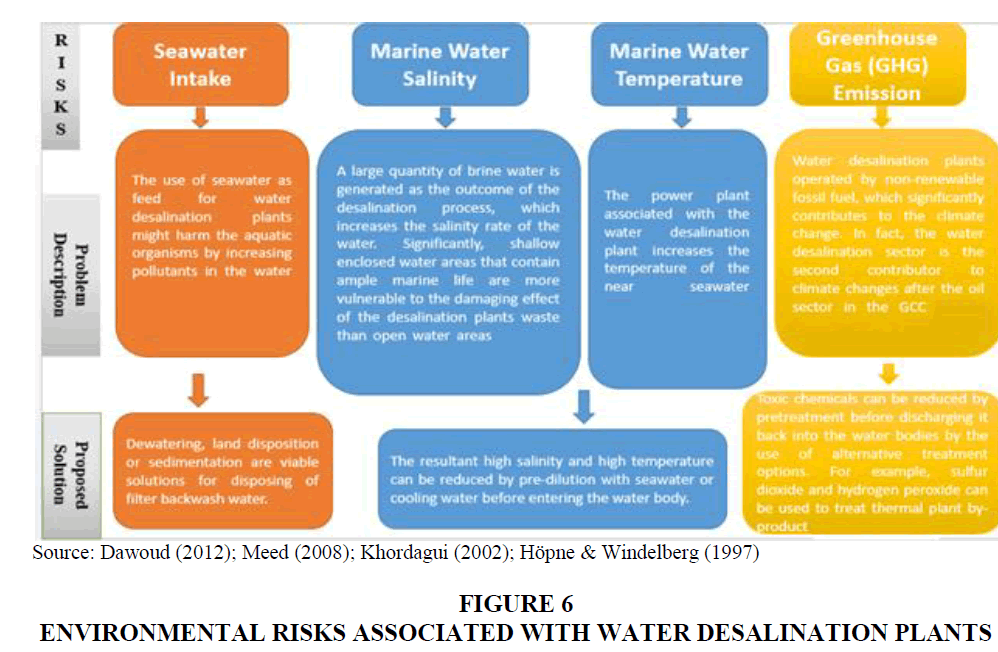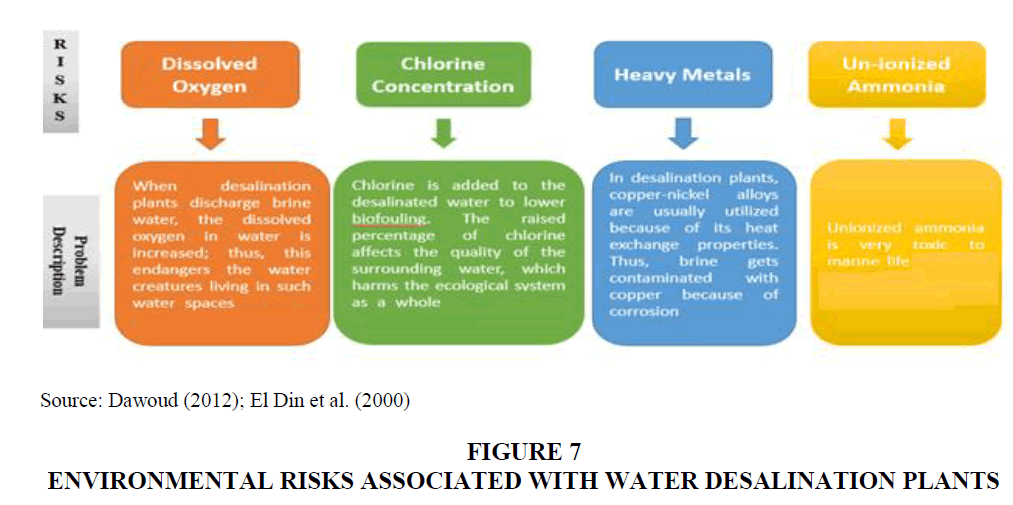Research Article: 2020 Vol: 19 Issue: 2
Strategic Risk Management (SRM): The Future of Desalination in the Gulf Cooperation Council (GCC)
Saad Z. Darwish, Kingdom University
Waleed K. Zubari, Arabian Gulf University
Abstract
The problem of water scarcity in the GCC is on the increase due to the rapid population growth and escalating water demands beyond the capacity of these countries conventional water resources consisting mainly of the groundwater, the majority of which are non-renewable, and limited rainfalls. To meet the ever-increasing demands, the GCC countries resorted to non-conventional water sources, namely: desalination to largely meet urban water demands and to treated wastewater to contribute to irrigation water demands. Because of the constraints associated with the reuse of the treated wastewater, desalination expansion seems to be the most viable solution to reduce the widening gap between water demands and supply. Unfortunately, desalination is associated with high financial and economic costs, and environmental risks. Therefore, the GCC must address this problem by setting risk management plans to ensure the provision of water for the current and future generations at the minimum financial, economic and environmental costs possible.
Keywords
Strategic Risk Management, Desalination, Water Resources, Scarcity, GCC.
Introduction
The Gulf Cooperation Council countries (GCC) are located in one of the world most water scarce areas (Figure 1), and have extremely poor endowment of fresh water resources. Erratic scanty rainfall and high temperatures leading to high vapor transpiration rates characterize the majority of the area of the GCC countries. The region is devoid of permanent freshwater bodies or rivers. The per capita share of renewable natural water in the GCC countries is one of the lowest worldwide, reaching less than 100 m3/year. This figure is tremendously less than the acute line of 500 m3/year of water poverty, which means that the countries suffer from total scarcity of water which is considered as one of the main restrictions on development (Falkenmark, 1989). In the past four decades, the GCC countries have experienced unprecedented socio-economic growth, which was associated with major increases in water demands. To meet these rapidly increasing water demands under the prevailing water scarcity conditions, the GCC countries relied on desalination to meet the water requirements, especially for drinking water supply. At present, municipal water supplies in the GCC main cities are mainly dependent on desalinated water. However, despite this high dependence, desalination remains an imported technology in the region and provides limited added value to the economies of the GCC countries. This research addresses the future of desalination from the perspective of strategic risk management with the aim of minimizing future risks on the desalination industry.
Literature Review
To satisfy the research objectives the researchers followed a direct pattern of review to summarize the important information of the sources and blend the re-organization of the information in a way that informs how we progress on examining the research problem. The investigative structure of the literature review will serve in providing an innovative understanding of thoughts or associate new with old interpretations. Doing this the researchers will identify the gaps in order to satisfy the research objectives. Here, we will surf the literature on desalination with the concepts used by SRM to create a notable association that assist decision makers to realize the role of SRM in achieving sustainability and water security for future generations.
Desalination in the GCC Countries
The GCC countries have experienced unprecedented development growth since the early 1970s due to the immediate increase in the countries’ earnings from oil, which has led to a fast increase in their economic base and an improvement in the standard of living and rapid population increase. During the period from 1970 to 2016, the population of the GCC countries increased by six folds, from about 7.6 million capita to about 53.3 million capita (Figure 2). Traditionally, and before the advent of this major development process, the GCC countries depended primarily on groundwater resources to meet their basic domestic and agricultural needs. The Rapid population growth and socio-economic development have resulted in extensive groundwater withdrawal leading to their over-exploitation in all the GCC countries. All the GCC countries have experienced groundwater deficit, i.e., groundwater abstraction is greater than groundwater recharge, as early as the 1980. The continuous water level declines and quality degradation by salinization is a clear manifestation of groundwater over-exploitation (Al-Zubari et al., 2017).
To meet the rising demands, particularly for the escalating demands of the domestic sector, the GCC countries resorted to the desalination technology, an option made possible by the energy and financial capabilities of the countries. While desalination was introduced in the GCC countries in the mid-1950s, it has developed very rapidly starting from the mid-1970s to counteract the shortages and quality deterioration in groundwater resources and to fulfill the specific requirements for drinking/domestic water standards. Figure 3 illustrates the trends in the Desalination capacity in the GCC countries. Currently, the domestic water supply in some of the GCC countries relies almost exclusively on desalinated water (Figure 4).
Currently, the GCC countries have more than 50% of the total desalination capacity of the world (Gleick et al. 2009). It is expected that the rates of increase in desalination capacity in these high-income, energy-exporting, countries will continue in the next decade to meet the escalating municipal and industrial water demands under the rapid growth rates of population and urbanization (Figure 5).
In addition, the costs associated with desalination expansion would be enormous. These are (Al-Zubari, 2014):
1) The required energy (oil and gas) for the production of desalinated water (involving both the opportunity cost and in-situ value);
2) The cost, both financial and energy/electricity, of every stage in the water cycle system operation (i.e., production, transmission, and distribution);
3) Environmental costs in terms of thermal brine discharge by desalination plants and their impacts on the surrounding coastal and marine environment, and air pollution by burned fossil and their impacts on the human health and environment.
Moreover, despite the heavy reliance on desalination in providing water supply and the significant current and future share of desalination capacity in the world, desalination remains an imported technology in the GCC countries. In addition, the desalination industry in the GCC countries provides limited added value to their economies, in terms of localizing operation and maintenance, plant fabrication, manufacturing of key spare parts and employed national labor. Added to the above, the environmental impacts of desalination have been overlooked. Under these conditions, strategic risk management becomes imperative for the GCC to ensure a secure desalination future where it would not only reduce the security concerns, but it would also become an integral part of their economy and socio-economic development.
The Concept and Phases of Risk Management
Risk definition
It is crucial to define risk in order to obtain a complete understanding of the strategic risk management as a discipline (Andersen, 2006). Risk is defined as “a condition in which there exists a quantifiable dispersion in the possible outcomes from any activity” (Collier & Agyei-Ampomah, 2009). Moreover, according to the International Organization for Standardization (ISO, 2018) in its ISO/IEC Guide 73 Risk Management, risk is “the combination of the probability of an event and its consequences” (The Institute of Risk Management, 2002). In other words, risk has two main aspects, namely, the possibility of an event and the related results that may be positive “opportunities” or negative “threats”. In this sense, risk management deals with both the upsides and downsides of risk. However, the nature of such consequences of an activity differs depending on the field. For example, in the safety field, consequences are always negative. Thus, the main objective of risk management in the safety field is the prevention of such consequence and the elimination of the damage (The Institute of Risk Management, 2002). According to Collier & Agyei-Ampomah (2009), there are many types of risks which could be business or operational, country, environmental, financial, reputational, or strategic. Operational risk is related to the activities whether being related to the public, employees, clients, products, services, systems, and processes. Country risks could be political, economic or regulatory. Environmental risks could be the result of changes that take place in politics, economy, socio-cultural factors, technology, environment or legal systems.
Risk management definition
It is defined as “a process of understanding and managing the risks that the entity is inevitably subject to in attempting to achieve its corporate objectives. For management purposes, risks are usually divided into categories such as operational, financial, legal compliance, information, and personnel” (Collier & Agyei-Ampomah, 2009). Risk management is a multifaceted process. It must be implemented carefully to achieve the desired results. Thus, certain steps must be followed. According to the National Institute of Standards and Technology (NIST, 2004), the risk management process includes a number of steps, namely: risk assessment (defining goals and context), risk reporting, decision-making, risk treatment, residual risk reporting, and monitoring. Nevertheless, this concept is used in the context of examining the process of risk management to control water scarcity and its associated risks.
This is essential for an overall efficient management and decision making at all levels of an entity. It is a practice that should be maintained on a regular basis in an organization (Berg, 2010). However, it is observed more remarkably in the departments concerned with environmental preservation, public health, and safety. For this purpose, a professional body at strategic governmental level can act as the source of risk management and control that is similar to other organizations dealing with risk. Risk management is controlled by many international standards and guidance documents prepared by special entities such as the International Organization for Standardization (ISO) (Luko, 2013). In addition, it is not something limited to the corporation or public organizations. In fact, the concept covers any short term or long-term activities done by all the stakeholders involved (The Institute of Risk Management, 2002). When applied appropriately, risk management contributes to the overall performance and thus, the improvement of operational efficiency at all levels (Nocco & Stulz, 2008). In general, risk management entails determining all pros and cons of all the factors of a certain activity and providing ways to maximize those pros and eliminate the cons. Thus, the probability of success of an activity rises while failure possibility goes down (The Institute of Risk Management, 2002). A continuous process should include all the risks surrounding all kinds of activities at any time.
Risk management processes
Risk assessment, which is the complete process of risk identification, description, analysis, and evaluation, is the first step in risk management. This step takes into consideration a team or a person who is acquainted with the mechanisms of SRM. However, this encompasses the legal, social, political, and cultural aspects of the environment. Thus, the identification of threats and opportunity is possible. In addition, risk assessment includes providing a complete description of the risks that state the risk nature, its scope, its quantification, the stakeholders concerned, tolerance, risk treatment and control mechanism, possible improving procedures, and policy formulation (Johnson, 2019). Risk reporting involves both internal and external reporting. On the one hand, internal reporting means notifying all the concerned levels that are able to take serious steps in this regard. On the other hand, external reporting means notifying stakeholders of the risks and the risk management policies being applied (the International Organization for Standardization (ISO/DIS) 31000, 2018). Thus, the risk management team should maintain both types of reporting.
Risk treatment is the phase during which measures are implemented to mitigate the risk. Treatment must involve an effective and efficient operation while using internal controls, and abiding by all laws and regulations (The Institute of Risk Management, 2002; Berg, 2010). Risk treatment is crucial to the risk management process. Finally, Reporting and monitoring a risk should aim at checking whether the procedures adopted have achieved the intended result and identifying the lessons that could be drawn to be used for future management measures (Borghesi & Gaudenzi, 2012). This step is vital for ensuring the efficiency of the risk management process in the long run.
Strategic Risk Management (SRM)
Strategic risk is related to the strategy adopted by an entity and the threats facing the fulfillment of such a strategy. Strategic risk is the obstacle that hinders the development and application of an entity’s strategy. It can result from an incorrect assessment of future trends. Specifically, strategic risk is associated with the long-term performance of any entity at a Macro or Micro level (Roberts et al., 2003). Porter & Advantage (1985) defines strategic risk as “a function of how poorly a strategy will perform if the ‘wrong’ scenario occurs”. There is a strong relationship between strategy and risk management. This relation is called strategic risk management. Good evidence by (Bromiley et al., 2016) is that the practice of SRM has the potential to contribute to the field enterprise risk management and to create value through efficient control of risks. Allan et al. (2007) stated that SRM is a multifaceted and complicated process due to its vigorous uncertainty and interconnectedness. This will tell us that there is a necessity to manage it as a complex process. Accordingly, Strategic Risk Management (SRM) is the process of pinpointing, monitoring, and dealing with the risk profile of an entity with the ultimate goal of protecting shareholders’ interests. Changes in the risk profile may lead to the need for revising or changing the strategic plan. In general, risk management encompasses four risk levels, namely: strategic risk, change risk, operational risk, and unforeseeable risk (Roberts et al., 2003). As such, Strategic Risk Management deals with the most critical risks to the shareholder value. Simply, strategic risk management starts with investigating the possibility of particular events and scenarios that may affect a business’s strategy implementation.
For this purpose, governmental institutions dealing with issues related to the public and economic security must have at hand a very effective system to monitor strategic risk. Water and desalination in GCC being one of the most important matters that needs close attention. The utmost challenge facing GCC governments is water scarcity. The population growth with the improvements in the style of living has more than doubled in the past few decades. However, water resources are depleting. The risk of a water crisis is considered as the major single risk facing MENA region and North Africa.There is a critical need for the formation of an up-to-date, effective and viable water industry. This should be done by following steps that create a smooth control of this strategic risk as indicated by (Rost, 2017). These steps are; outlining government strategy and objectives; creating key performance indicators (KPIs) to measure results; identifying the risks that can make inconsistency in performance; and preparing integrated reporting and monitoring.
Education Sectors for the Staff of Desalination Plants
The GCC countries have high capacity desalination plants that make them the world leader in the use of desalination technology. Currently, the GCC possess more than 50% of the desalination capacity of the whole world. Moreover, they have plans for constructing more plants with even increasing capacities. This indicates that the exponential growth in desalination will continue along with new related innovations and techniques. Thus, the need for more highly trained professionals in desalination is growing in parallel with the increase in the number and capacity of water desalination plants in the region. Therefore, achieving educational and professional development in this field becomes essential. The development of professional and technical capacity in desalination and the establishment of an advanced joint GCC R&D base in desalination would be instrumental in enhancing desalination sustainability in these countries. For this purpose, reviewing the present policies and practices associated with desalination is necessary, including the current knowledge (Al-Rashed & Sherif, 2000).
In general, there are four levels for desalination education (Kennedy et al., 2001; Ettouney & El-Dessouky, 2001): undergraduate engineering, graduate engineering, training and courses, research as Master and Doctoral degrees. The main object behind providing such different levels of education on water desalination is to qualify the work force in a comprehensively theoretical and practical way. Across the GCC countries, there exist several universities that provide a desalination curriculum, but it is only a division of a larger discipline of study such as chemical, civil or mechanical engineering. Examples of such universities include Kuwait University in Kuwait, King Abdul-Aziz University, King Fahd University, and King Saud University in Saudi Arabia. Some of these universities offer a compulsory undergraduate course in desalination for undergraduate Engineering students, while others provide a water desalination course as optional. However, it is noteworthy that the research and development (R&D) carried out in the region’s universities are quite limited compared to the existing desalination capacity installed in the region. This could be attributed to different reasons, such as the lack of contact with the manufacturers and limited access to developmental materials (Temperley, 2002). Moreover, the region has several institutes and organizations that support educational courses and training in the desalination sector. Example of the most important ones is (Schenkeveld et al., 2004):
- MEDRC (the Middle East Desalination Research Centre) is an organization that aims to enrich and spread the desalination technology in order to moderate its prices. It depends on the fund from third parties. MEDRC contributed to the education on desalination by providing training programs and academic interchange.
- The Saline Water Conversion Corporation (SWCC, 2014) is the Saudi body responsible for water desalination in the country. The corporation has its own research and development Centre that invented the Nano method of desalination by using microfiltration membranes. SWCC has a training center and provides training and educational programs for thousands of Saudi employees providing them with the latest technical skills.
- Dar Al-Tanqniya Institute is part of Bushnak Group, a private technology cooperative of scientists and engineers, which supports the desalination sector by design and technical services, in addition to a variety of training and educational programs.
- Mohammed Bin Rashid Technology Park in Dubai is mainly concerned with attracting foreign technology and actualizing it in the Arab region.
However, despite the fact that the region has exceptional local engineers, their number is not enough to fulfill the ever-increasing needs of the region for more desalinated water. The government should support the local talent. Otherwise, the current state will remain dependent on imported talents (Al-Rashed & Sherif, 2000). The quality of actors in this field is as important as the technology itself. The operational environment and the enabling environment in the desalination sectors must be given due attention. This means managers and technical staff must be trained and prepared well, to ensure that they perform well and produce a high-quality outcome.
Risk Associated with Water Desalination: Ways to mitigate them
Water desalination is accompanied by many environmental impacts in the GCC including encroachment on marine organisms due to the intake of seawater, the Green House Gases emission, because of the fossil fuel burned by such plants, and the discharge of brine water into the marine environment (Dawoud, 2012). These environmental risks associated with water desalination plants are listed in Figures 6 and 7. However, these are all limited scope solutions as they only reduce the hazardous effect of such waste, but cannot entirely eliminate it (Dawoud, 2012). Accordingly, there is a pressing need for finding and developing a new more effective process for the management of brine resulting from the desalination process.
The Way Forward: Future Strategic Initiatives
Professionals in industry consider that the founding of the desalination manufacturing sector in the GCC will initiate new prospects for this industry over the next few years (Menadesal, 2019). Now we are seeing a growth in the number of investments in the desalination sector that is likely to improve its role and contribution to the economy in the region. However we must not underestimate the energy issue and move to renewable energy as a source for cost effective implementation for this industry (Darwish et al., 2018)
By referring to many sources, the researchers believe that the GCC governments must pay more attention to universities and research bodies to secure water resources for future generations. Forming these bodies and research groups will keep an eye on any development in this vital sector. An excellent attempt by the GCC is published by Desalination Experts Group (2014) with document of “Desalination in the GCC, History, Present & Future” in 2014, which draws a clear line for future development by referring to the history of desalination in GCC. Furthermore, R&D performs an important role in the innovation process. This should lead fundamentally to the exploitation of technology and future capabilities, which is converted into new services and products. When considering R&D, innovation should boost investment for future development. Reasonable investment in R&D will initiate new and better projects in the desalination sector. It has a vast influence on knowledge creation. That falls down to useful knowledge that the government can use to develop the desalination industry.
Good examples where fundamental business and socio-economic growth of the Dubai had contemplated via technological start-ups and SMEs which represent 95% of the business sector, account for 86% of the workforce and contribute to around 60% of the non-oil GDP. This will result in developing innovation and strengthening the economy. A number of innovation incubators and accelerators have also been established and initiated throughout the UAE. Saudi Arabia determined that young entrepreneurship and innovations in the field of science and technology are the next most economically effective forces after the oil industry. The Government is working towards implementing Vision 2030, which was released in April 2016 and which includes 80 projects costing up to US$3.7 million. There are other attempts by GCC countries. However, it is not clear how this will benefit the desalination sector. It is essential to allow for investment in this vital sector. Further universities and specialized programs and curriculum must take their role in preparing and graduating specialized engineers in the different disciplines in desalination projects. This must be associated with securing work forces that are vocationally trained for this same purpose which is developing desalination through vocational training at polytechnics and training institutions.
A key factor in the design and operation of desalination technologies is the environmental issues related to desalination. Meeting regulations and being cost effective construction wise and efficient in management, operations and monitoring risk factors are a prime concern for desalination industry. Issues such as the location of desalination plant, the structures of water intake, and concentrate management and disposal are within the main environmental concerns. Therefore, the concerns here is; How to identify, measure, control and mitigate these risks.
Methodology
This exploratory study focuses on examining secondary data and sources through conducting literature review. The present study aims at examining the problem of the desalination industry in the whole GCC region from a wider scope to highlight the need for more and a stronger cooperation between the member countries. To explore and show how to have a well and thoughtful idea of the existing situation, we start with a broad notion and use this study as a source to recognize certain problems that we are able to emphasize for future research and expose a new direction. Furthermore, the methodology adopted for this paper is to follow a broad review of the contemporary literature to foresee how Strategic risk management will help in developing desalination projects to serve the GCC economy. Using a broad analysis of the secondary data and literature where the researchers challenge to articulate a future research by evolving actions to support the GCC. By following systematically the development of this endeavor the researchers tries to lay foundation on how SRM is implemented to assist in meeting future water shortages. Secondary data was collected from regional and international documents and data to reflect on the standing of desalination in GCC. A systematic relationship between SRM Desalination demonstrates how to accomplish the paper’s objectives. The main objective of this research is to highlight the main issues and challenges facing the desalination industry and the role of strategic risk management in creating a sustainable desalination industrial sector in the GCC countries. It attempts to support GCC governments’ decision makers to plan with a vision of establishing an effective and sustainable desalination industry that responds to the GCC water security requirements for future generations.
The research questions are; what are the best available solutions that SRM can provide to overcome the problems of localizing the industry? How important it is to achieve sustainability of the desalination sector by using SRM techniques in the GCC countries?
Results and Discussion
Desalination challenges are not only environmental risks (GHGs emission and effluent discharge to the marine environment), but are also associated with many risks related to other sources of risk. Mainly, technology acquisition of desalination, which is still an imported technology, and desalination sector limited benefit to national economies represent the main challenges of risks. Looking at the problem from another perspective, we notice that the lack of national qualifying specialists and labor, energy-intensive technology is of paramount importance in this sense. This gives an impression of a lack of sustainability. One may argue how these economies will survive in contingent situations or even during normal circumstances. There are some encounters that will affect the economic growth and prosperity; e.g. Escalating fossil energy consumption and energy inefficiency. If we go further to look into the risks of having desalination plants shut down due to a number of marine pollution/accidents/wars and combats, these are major risks for municipal water supply security. Good to mention that the GCC Unified water strategy has set a number of programs and initiatives to combat these issues (lower, prevent, avoid and manage these risks). Therefore, water desalination is regarded highly by all GCC countries. As shown previously, there is a great dependability on desalinated water as a main source of fresh water. The increasing demand for desalinated water pressures government to increase investment in establishing more desalination plants. The Kingdom of Saudi Arabia is the world leader in desalination capacity, followed by the United Arab Emirates. As the population grows, more plants are to be built to cater for the ever-increasing demand for water in the gulf area.
Conclusion and Recommendations
According to the current conditions of the water sources and desalination in the GCC, the recommendations would be to contribute to developing sustainable fresh water while preserving the environment:
1. Due to the lack of research on SRM, it is recommended to use extensively the techniques that will support the field of water desalination in the GCC in order to set clear and specific plans. Officials responsible for water must incorporate risk management thinking and approach in their short term and long term plans to address and face the challenges of water scarcity and find the most applicable solutions.
2. It is a fact that water sources in the GCC are rare and on the decline, because of the growing population growth accompanied by the overuse of water sources. This risk need to be considered by decision makers. Therefore, education and awareness together with water use rationalization policies must be introduced and implemented carefully. For example, wastewater treatment can be implemented in a larger scope to cover the use of water for purposes other than drinking. Media is a good way to raise people awareness on the problem.
3. Due to the scarcity of freshwater sources in the GCC region, it is reasonable to invest heavily in the establishment of desalination plants of huge capacities. On the other hand, it is equally important to allocate enough funds and investments for qualifying engineers and staff for the efficient operation of these facilities to reduce the dependency on importing qualified work force. The cost saved from importing experts in the field can be allocated to research and development.
4. SRM will help in fulfilling the water demands of the current generation. In addition, it is of significant importance to preserve the environment and the water sources for the coming generation, and exerting considerable efforts and funds in adopting the latest environmentally friendly desalination technology.
5. GCC countries must cooperate to face the problem of water scarcity with a larger budget for R&D, more experts, and more effort on the problem; it becomes easier to find viable solutions.
6. The education (Academic and vocational Sector) must have a pioneering role in preparing the required work force that can create independence and sustainability for this vital economic sector.
7. To manage strategic risk by scrutinizing what decision makers and related institutions can analyze how risk is threating this vital source of life.
References
- Allan, N., Davis, J., & Godfrey, P. (2007). Ten steps to managing strategic risk-a holistic approach. In Proceedings of the Institution of Civil Engineers-Civil Engineering. Thomas Telford Ltd.
- Al-Rashed, M.F., & Sherif, M.M. (2000). Water resources in the GCC countries: an overview. Water Resources Management, 14(1), 59-75.
- Al-Zubari, W. (2014). The costs of municipal water supply in Bahrain.
- Al-Zubari, W., Al-Turbak, A., Zahid, W., Al-Ruwis, K., Al-Tkhais, A., Al-Muataz, I., Abdelwahab, A., Murad, A., Al-Harbi, M., & Al-Sulaymani, Z. (2017). An overview of the GCC unified water strategy (2016-2035). Desalination and water Treatment, 81(s 5).
- Andersen, T.J. (2006). Perspectives on strategic risk management. Copenhagen Business School Press DK.
- Berg, H.P. (2010). Risk management: procedures, methods and experiences. Reliability: Theory & Applications, 5(2 (17)).
- Borghesi, A., & Gaudenzi, B. (2012). Risk management: How to assess, transfer and communicate critical risks. Springer Science & Business Media.
- Bromiley, P., Rau, D., & McShane, M.K. (2016). Can strategic risk management contribute to enterprise risk management? A strategic management perspective. A Strategic Management Perspective. Forthcoming: Bromiley, P., Rau, D., and Mcshane, M, 140-156.
- Collier, P.M., & Agyei-Ampomah, S. (2009). CIMA Official Learning System Performance Strategy. Elsevier.
- Darwish, S., Abdo, H., & Alsabuwaiee, W. (2019). Opportunities, challenges and risks of transition into renewable energy: The case study of arab gulf cooperation council. International Energy Journal, 18(4).
- Dawoud, M.A. (2012). Environmental impacts of seawater desalination: Arabian Gulf case study. International Journal of Environment and Sustainability, 1(3).
- Desalination Experts Group. (2014). Desalination in the GCC: The history, the present, and the future. GCC: The Cooperation Council for the Arab States of the Gulf (GCC) General Secretariat.
- El Din, A.S., Arain, R.A., & Hammoud, A A. (2000). On the chlorination of seawater. Desalination, 129(1), 53-62.
- Ettouney, H., & El-Dessouky, H. (2001). Teaching desalination. Desalination, 141(2), 109-127.
- Falkenmark, M. (1989). The massive water scarcity now threatening Africa: Why isn't it being addressed?. Ambio, 112-118.
- Gleick, P.H., Cooley, H., & Cohen, M.J. (2009). The world's water 2008-2009: The biennial report on freshwater resources. Island Press.
- Höpner, T., & Windelberg, J. (1997). Elements of environmental impact studies on coastal desalination plants. Desalination, 108(1-3), 11-18.
- ISO. (2018). Risk management principles and guidelines on implementation. International Organization for Standardization.
- Johnson, L. (2019). Security controls evaluation, testing, and assessment handbook. Academic Press.
- Kennedy, M., Bremere, I., & Schippers, J. (2001). Capacity building in desalination: a case study on selected activities in the Netherlands. Desalination, 141(2), 199-204.
- Khordagui, H. (2002). Environmental impacts of power-desalination on the gulf marine ecosystem. The Gulf Ecosystem: Health and Sustainability, Backhuys Publishers, Leiden, 173-191.
- Luko, S.N. (2013). Risk management terminology. Quality Engineering, 25(3), 292-297.
- Meed. (2008). Power and water in the GCC: the struggle to keep supplies ahead of demand report; research and markets. Dublin: Taylors Lane.
- Menadesal.(2019). Retrieved from https://menadesal.com/wp-content/uploads/2019/02/MENA-Desalination-Market-Report.pdf
- NIST. (2004). Risk management guide for information technology systems. National Institute of Standards and Technology.
- Nocco, B.W., & Stulz, R.M. (2008). Enterprise risk management theory and practice. Journal of Applied Corporate Finance, 18(4).
- Porter, M.E., & Advantage, C. (1985). Creating and sustaining superior performance. Competitive Advantage, 167, 167-206.
- Roberts, A., Wallace, W., & McClure, N. (2003). Strategic risk management. Pearson Education.
- Rost, M. (2017). 5 steps to effective strategic risk management. Retrieved February 14, 2017 from https://www.workiva.com/blog/5-steps-effective-strategic-risk-management
- Schenkeveld, M.M., Morris, R., Budding, B., Helmer, J., & Innanen, S. (2004). Seawater and brackish water desalination in the Middle East, North Africa and Central Asia. World Bank.
- SWCC. Saline Water Conversion Corporation website. (2014). Annual report. Retrieved from https://www.swcc.gov.sa/english/MediaCenter/SWCCPublications/PUBLICATION%20FILES/ANNUAL%20REPORT%202014ENC02348BB-A1D8-4029-BFE3-136FA70DAB0B.PDF
- Temperley, T. (2002). Planning, management, operation and maintenance of desalination plants. Encyclopedia of Desalination and Water Resources (DESWARE).
- The Institute of Risk Management (2002). A risk management standard. England: IRM.
- United Nations. (2013). Water governance in the Arab region: Managing scarcity and securing the future. New York: Author.
